
The shroud enveloping the elephant at HK6 Tomb 23 with a weave of 20 x 11 threads per cm and estimated to cover 20m2, it would have required some 60km of thread to make. Experiments have shown that an experienced spinner can spin 58m of linen thread per hour, so a single person would have had to work 1,071 hours just to produce the thread. When the weaving process is added, the shroud would have taken a single worker toiling 8 hours a day no less than 191 days - or more than 6 months. Since this is certainly not the only piece of textile from Hierakonpolis, and not the finest (that is 30 x 30 threads per cm), a fair number of persons must have been working in textile production full time.
The majority of the spindle whorls were found at the HK29A ceremonial centre, indicating that along with finely crafted lithics, stone vessels and semi-precious beads, fine textiles were being produced for the elite here.
The textiles so far examined from HK43 (Naqada IIB) are all produced from yarns spun by the new method.
 |
| C-Ware elliptical bowl from Tomb 3802 at Badari, Naqada IA-IIB period |
 |
| Weaving scene on tablet, Susa, 3800-3100 BC |
 |
| Tablet (P333415), Susa, ca. 3500-3350 BC |
 |
| Cylinder seal with banquet and weaving, Mari, 2500-2340 BC |
References:
http://www.hierakonpolis-online.org/index.php/nekhen-newsFebruary 26, 2025 Takahiko Nakagawa